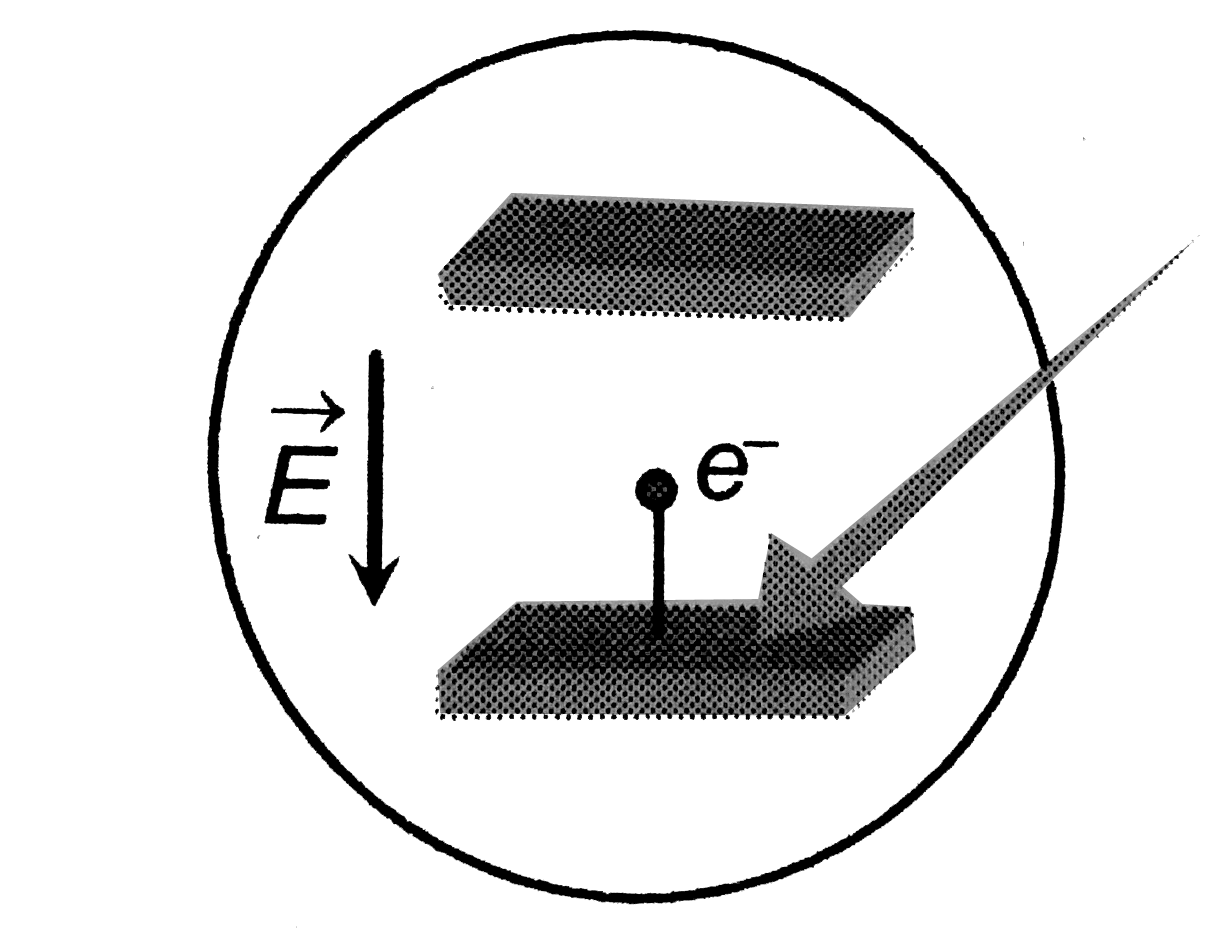In a photoelectric experiment, the collector plate is at 2.0 V with respect to the emitter plate made of copper ϕ=4.5. The emitter is illuminated by a source of monochromatic light of wavelength 200nm. Find the minimum and maximum kinetic energy of the photoelectrons reaching the collector.Solution in Tamil
Given ϕ=4.5eV,λ=200nm
Stopping Potential of energy
=E−ϕ=hcλ−ϕ
=1242200−4.5
=6.21−4.5=1.71eV
Minimum 1.7 V is necessary to stop the electron. The minimum K.E.=2eV Since the electric potential of 2V is required to accelerate the electron to reach to plates. The max. K.E.
=(2+1.7)eV=3.7eV
Topper's Solved these Questions
- PHOTO ELECTRIC EFFECT AND WAVE PARTICLE DUALITYBOOK - HC VERMACHAPTER - PHOTO ELECTRIC EFFECT AND WAVE PARTICLE DUALITYEXERCISE - objective II
7 Videos
- PERMANENT MAGNETSBOOK - HC VERMACHAPTER - PERMANENT MAGNETSEXERCISE - Exercise
25 Videos
- PHOTOMETRYBOOK - HC VERMACHAPTER - PHOTOMETRYEXERCISE - All Questions
44 Videos
Similar Questions
When the intensity of a light source is increased.
View SolutionA long bar magnet has a pole strength of 10Am. Find the magnetic field at a point on the axis of the magnet at a distance of 5cm from the north pole of the magnet.
View SolutionFind the luminous flux of 10 W source of 600 nm. The relative luminosity at 600 nm is 0.6.
View SolutionIn an experiment on photoelectric effect light fo wavelength 400 nm is incident on a metal plate at rate of 5W. The potential of the collector plate is made sufficiently positive with respect to emitter so that the current reaches the saturation value. Assuming that on the average one out of every 106 photons is able to eject a photoelectron, find the photocurrent in the cirucuit.
View SolutionThe collector plate in an experiment on photoelectric effect is kept vertically above the emitter plate . Light source is put on and a saturation photo current is recorded . An electric field is switched on which has a vertically downward direction . Then

View Solution(a) 1 mW of light of wavelength 456 nm is incident on a cesium surface. Calculate the photoelectric current produced, if the quantum efficiency of the surface for photoelectric emission is only 0.5%.
(b) In an experiment on photoelectric effect, light of wavelength 400 nm is incident on a cesium plate at the rate of 5.0W. The potential of the collector plate is made sufficiently positive with respect to the emitter so that the current reaches its saturation value. Assuming that on the average one out of every 106 photons is able to eject a photoelectron, find the photocurrent in the circuit.
View Solution(a) In a photoelectric experiment, the collector plate is at 2.0 V with respect to the emitter plate made of copper (phi =4.5 eV) . The emitter is illuminated by a source of monochromatic light of wavelength 200 nm. Find minimum and maximum kinetic energy of the photoelectrons reaching the collector. (b) A small piece of cesium metal (phi =1.9 eV) is kept a distance of 20 cm from a large metal plate having a charge density of 8.85xx10^(-9) C//m^(2) on the surface facing the cesium piece. A monochromatic light of wavelength 400 nm is incident on the cesium piece. Find minimum and the maximum kinetic energy of the photoelectrons reaching the large metal plate. Neglect any change in the electric field due to the presence of small piece of cesium.
View SolutionIn a junction transistor the emitter, base and collector are made of.
View SolutionThe collector plate in an experiment of photoelectric effect is kept vertical above the emitter plate. Light source is put on, and a saturation photocurrent is recorded. An electric field is switched on which has a vertically downward direction-
View SolutionThe collector plate in an experiment on photoelectric effect is kept vertically above the emitter plate. Light source is put on and a saturation photo current is recorded. An electric field is switched on which has a vertically downward direction
View SolutionWhen light of wavelength 3600 nm falls on a photosensitive plate, photoelectrons are emitted. However, for another photoelectric emitter, light of 6000 nm is sufficient to produce photoemission. What is the ratio of the work functions of the two emitters ?
View SolutionIn a transistor, the emitter , base and collector are respectively
View SolutionIn an experiment on photoelectric effect light of wavelength 400nm is incident on a metal plate at rate of 5W. The potential of the collector plate is made sufficiently positive with respect to emitter so that the current reaches the saturation value. Assuming that on the average one out of every 106 photons is able to eject a photoelectron, find the photocurrent in the circuit.
View SolutionThe collector plate in an experiment on photo electric effect is kept vertically above the emitter plate. Light source is put on and a saturation photo current is recorded. Parallel electric and magnetic fields are applied vertically downwards between the plates. Then
View SolutionIn an experiment on photoelectric effect of light wavelength 400 nm is incident on a metal plate at rate of 5W. The potential of the collector plate is made sufficiently positive with respect to emitter so that the current reaches the saturation value. Assuming that on the average one out of every 106 photons is able to eject a photoelectron, find the photocurrent in the cirucuit.
View SolutionIn a transistor, the emitter , base and collector are respectively
View Solution
